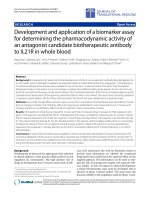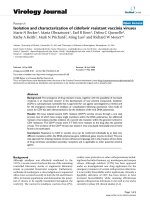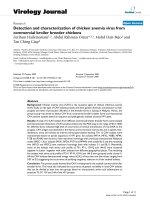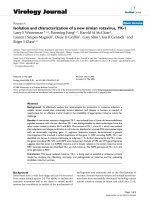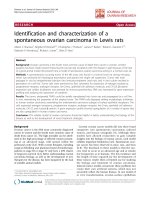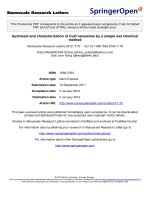Báo cáo hóa học: " Synthesis and characterization of integrated layered nanocomposites for lithium ion batteries" ppt
Bạn đang xem bản rút gọn của tài liệu. Xem và tải ngay bản đầy đủ của tài liệu tại đây (1.57 MB, 9 trang )
NANO EXPRESS Open Access
Synthesis and characterization of integrated
layered nanocomposites for lithium ion batteries
Jihyeon Gim, Jinju Song, Hyosun Park, Jungwon Kang, Kangkun Kim, Vinod Mathew and Jaekook Kim
*
Abstract
The series of Li[Ni
x
M
x
Li
1/3-x
Mn
2/3-x
]O
2
cathodes, where M is cobalt or chromium with a wide compositional range x
from 0 to 0.33, were prepared by hydroxide coprecipitation method with subsequent quenching. The sample
structures were investigated using X-ray diffraction results which were indexed completely on the basis of a
trigonal structure of space group
¯
R3m
with monoclinic C2/m phase as expected. The morphologies and
electrochemical properties of the samples obtained were compared as the value of x and substituted transition
metal. The particle sizes of cobalt-substituted Li[Ni
x
Co
x
Li
1/3-x
Mn
2/3-x
]O
2
samples are much smaller than those of the
Li[Ni
x
Cr
x
Li
1/3-x
Mn
2/3-x
]O
2
system. The electrode containing Li[Ni
x
Co
x
Li
1/3-x
Mn
2/3-x
]O
2
with x = 0.10 delivered a
discharge capacity of above 200 mAh/g after 10 cycles due to the activation of Li
2
MnO
3
.
PACS: 82.47.Aa; 82.47 a; 82.45.Fk.
Keywords: lithium ion batteries, cathode s, nanocomposites, coprecipitation
Introduction
The development of rechargeable lithium ion batteries
depends critica lly on the technological advances in elec-
trode materials. Over the years, several compounds such
as spinel LiMn
2
O
4
, olivine LiFeP O
4
[1], and layered
LiCoO
2
and LiNiO
2
have been studied extensively by
many researchers as cathode materials for lithium ion
batteries. In fact, LiMn
2
O
4
and LiFePO
4
have distinct
advantages of being cost-effective and environmentally
benign. However, LiMn
2
O
4
suf fers from capaci ty fading
due to the dissolution of manganese and Jahn-Teller
distortion [2,3], while LiFePO
4
delivers insufficient capa-
city and low electronic conductivity [4].
Commercially used LiCoO
2
cathode has advantages of
easy synthesis and excellent lithium ion mobility though
challenging issues of stability, achieving practical capaci-
ties, and environmental risks need to be addressed [2].
The layer-structured rhombohedral Li MnO
2
(
¯
R3m
)
attracts interest as a potential cathode due to its cost
effectiveness and relatively high capacity, but it exhibits
severe capacity fading during extended cycling. More
precisely, its discharge behavior during electrochemical
cycli ng needs significant improvement. The strategies to
overcome such limitations in rhombohedral LiMnO
2
havebeenfocusedonmetalionsubstitution[5,6].Due
to its higher theoretical capacity, LiNiO
2
has also been
investigated as an alternative cathode to commercial
LiCoO
2
. However, it is complicated to synthesize a
pure-layered structure with a well-ordered phase
because of severe cationic disordering between nickel
and lithium ions that occurs due to the ionic radii
values of Ni
2+
(0.069 nm) and Li
+
(0.068 nm) being
almost similar. Further, ca pacity fading occurs during
dischargesincetheelectronicstateinlowspinNi
3+
serves as the satisfactory condition for the Jahn-Teller
distortion observed in the spinel LiMn
2
O
4
.
In light of the above discussions, many researchers
have investigated on the strategies to repl ace LiCoO
2
.
First, alien transition metal ions such as Ni, Mn, and Cr
could be introduced in order to exploit their advantages
of stable and high redox-couple properties. Second, by
combining stable Li
2
MnO
3
as an inactive frame with
layered LiMO
2
, lithium-saturated solid solutions or
nanocomposite xLi
2
MnO
3
·(1-x)LiMO
2
with prolonged
structural integrities have been researched to take
advantage of their stable and rigid structure [7-11].
Here, Li
2
MnO
3
, which has a lay ered rock salt structure
(space group
¯
R3m
) with a monoclinic phase (C2/m),
can be represented in layered form as Li[Li
1/3
Mn
2/3
]O
2
.
* Correspondence:
Department of Materials Science and Engineering, Chonnam National
University, 300 Yongbongdong, Bukgu, Gwangju, 500-757, South Korea
Gim et al. Nanoscale Research Letters 2012, 7:60
/>© 2012 Gim et al; licensee Springer. This is an Open Access article distributed under the terms of the Creative Commons Attribution
License ( which permits unrestricted use, distribution, and reprod uction in any medium,
provided the original work is properly cited.
Further, the nanocomposites can be represented by the
notation, Li[M
1-x
Li
x/3
Mn
2x/3
]O
2
with a layered structure
[12-14]. Our earlier work was focused on investigating
one such nanocomposite electrode namely, 0.4Li
2
M-
nO
3
·0.6LiMO
2
(M = Ni
1/3
Co
1/3
Mn
1/3
and Ni
1/3
Cr
1/
3
Mn
1/3
) [13]. The encouraging results obtained from
that study led us to investigate the physicochemical
properties of the doped nanocomposites with a layered
structure over a range of stoichiometric compositions.
Therefore, the present work reports on the synthesis
and systematic investigations on th e structure, morphol-
ogy, and electrochemical performances of an integrated
layered nanocomposite system, viz Li[Ni
x
M
x
Li
1/3-x
Mn
2/3-
x
]O
2
, where M is cobalt or chromium with a wide com-
positional range x from 0 to 0.33. Ultimately, it is aimed
to arrive at the optimized compositions (x)ofCoand
Cr in the integrated nanoc omposite t hat exhi bit
impressive electrochemical properties.
Methods
Synthesis
Lithium hydroxide monohydrate (98.0% to approximately
102.0%; Junsei Chemical Co., Ltd., Chuo-ku, Tokyo,
Japan), manganese acetate tetrahydrate (97%; Yakuri Pure
Chemicals Co., Ltd., Kyoto, Japan), nickel acetate tetrahy-
drate (98.0%, Junsei Chemical Co., Ltd.), Cobalt acetate
tetrahydrate (98.5%, Junsei Chemical Co., Ltd.) and Chro-
mium acetate (22% as Cr, Wako Pure Chemical Industries,
Ltd., Chuo-ku, Osaka, Japan) were used as precursors for
the solution synthetic method. The samples with different
stoichiometric compositions in the layered Li[Ni
x
M
x
Li
1/3-
x
Mn
2/3-x
]O
2
system where x = 0, 0.05, 0.1, 0.17, 0.24, and
0.33 were prepared by coprecipitation method. In brief,
the transition metal acetate precursors and lithium hydro-
xide were dissolved separately in distilled water. The aqu-
eous solution of lithium hydroxide was then slowly
dripped into the transition metal solution to facilitate
hydroxide coprecipitation at room temperature for 24 h.
The precipitated solution was subsequently dried in an
oven at 85°C to evaporate residual water, and the dried
powders were ground well before heating at 600°C for 3 h
to eliminate undesired organic materials that remained.
The heated powders were ground complete ly and then
fired at 900°C for 12 h for crystallization. The resultant
powders were obtained after quenching the fired powders
using two copper plates in air and s ubsequent grinding.
The final products were obtained after washing with dis-
tilled water to remove unwanted impurities such as
Li
2
CrO
4
and subsequent vacuum drying at 120°C.
Structural and physical characterization
The crystalline nature of the obtained samples in the Li
[Ni
x
M
x
Li
1/3-x
Mn
2/3-x
]O
2
system were characterized by
X-ray diffraction [XRD] using a Shimadzu X-ray dif-
fractomet er (Shimadzu Corporation, Nakagyo-ku, Kyoto,
Japan) with Ni-filtered Cu-Ka radiation (l =1.5406Å)
operating at 40 kV and 30 mA within the scanning
range angle from 10° to 80° (2θ). Inductively coupled
plasma atomic emission spectrometer [ICP-AES] analy-
sis utilizing PerkinElmer OPTIMA 4300 DV (PerkinEl-
mer, Waltham, MA, USA) was performed to confirm
the compositions of the obtained materials. The p article
morphologies and sizes were observed by field-emission
scanning electron microscopy [FE-SEM] using the
HITACHI S-4700 instrument (Hitachi High-Tech, Min-
ato-ku, Tokyo, Japan). The sample surface areas were
measured by the Brunauer Emmett and Teller [BET]
method using a surface area analyzer (ASAP 2020,
Micromeritics Instrument Co., Norcross, GA, USA).
Electrochemical characterization
The electrochemical properties of the cathodes fabri-
cated from the samples in the Li[Ni
x
M
x
Li
1/3-x
Mn
2/3-x
]O
2
system were evaluated using the NAGANO battery tes-
ter system 2004H equipment (NAGANO KEIKI Co.,
LTD, Ohta-ku, Tokyo, Japan). The fabricated cathode
consisted of 72 wt.% active materials, 10 wt.% conduc-
tive carbon (Ketjen black), and 18 wt.% polytetrafluor-
oethylene as binder. The pasted film was then pressed
onto a stainless steel mesh with a 2-cm
2
area and dried
under vacuum at 120°C for 12 h. The electrolyte
employed was a 1:1 (v/v) mixture of ethylene carb onate
and dimethyl carbonate containing 1 M LiPF
6
. A 2032
coin-type cell which consists of the cathode and lithium
metal anode separated by a polymer membrane was fab-
ricated in an Ar-filled glove box and aged for 12 h. The
cell s assembled were tested with 0.1 mA/cm
2
of current
density in the voltage range from 2.0 to 4.8 V.
Results and discussion
The Li[Ni
x
Co
x
Li
1/3-x
Mn
2/3-x
]O
2
system
Figure 1 shows the XRD patterns of layered nanocom-
posite powders obtained by coprecipitation and belong-
ing to the Li[Ni
x
Co
x
Li
1/3-x
Mn
2/3-x
]O
2
system. All
diffraction peaks of the prepared samples were assigned
to the expected reflections of t rigonal (
¯
R3m
)and
monoclinic (C2/m) phases simultaneously, except for
the sample with composition x = 0. Particularly, a mag-
nified view of the scanning angles ranging from 2θ = 19°
to 34° indicate peaks arising due to the super-lattice
ordering of Li
+
and Mn
4+
occurring in the transition
metal layers. Li
2
MnO
3
can be represented as Li[Li
1/
3
Mn
2/3
]O
2
, a layered phase possessing long-range order-
ing in the transitio n metal layers. Such a cation ordering
can correspond to well-resolved characteristic peaks at
specific angles in t he XRD patterns. These peaks
Gim et al. Nanoscale Research Letters 2012, 7:60
/>Page 2 of 9
indicating long-range ordering are distinctly visible and
sharper in pure Li
2
MnO
3
(x = 0), when compared with
the other samples in this system. As the XRD patterns
of the samples with increasing concentrations of x are
viewed progressively, the characteristic peaks corre-
sponding to cation ordering undergo a significant varia-
tion in their intensities. In fact, the peaks which indicate
the cation ordering in transition metal layer disappear
gradually, as we observe the characteristic peaks of the
samples with increasing concentrations of x in the mag-
nified image. To confirm the stoichiometric composition
of the synthesized materials, ICP-AES analysis was per-
formed, and the results are summarized in Table 1. The
ICP results revealed that the observed stoichiometric
composition for transition metals in all the samples
matched well with the calculated values. Despite the fact
that an excess 3 wt.% lithium precursor was used as
starting material, the experimental lithium content in all
samples was slightly lower than the corresponding theo-
retical values. This lower lithium content most probably
resulted from the evaporation loss of lithium during
heat treatment at elevated temperatures. The possibili-
ties for such lithium losses during high temperature
synthesis of layered electrodes have been reported
[12,15].
The morphology and size distribution of the Li[Ni
x-
Co
x
Li
1/3-x-
Mn
2/3-x
]O
2
system were examined by FE-SEM
and is shown in Figure 2. From the SEM results, it is
observed that the average particle size of the parent
Li
2
MnO
3
(sample with x =0)isintherangeof4μm.
On doping with Co, the particle sizes of the doped sam-
ples tend to decrease, which might probably be due to
the comparatively smaller ionic radius of Co
3+
(0.053
nm) than t hat of Ni
2+
(0.07 nm). A similar trend
observed by researchers has been reported for Cr-dop-
ing in layered lithium manganese oxides [16,17]. The
surface areas pertaining to the prepared samples which
were calculat ed usi ng the BET method indicate that the
obtained values for the doped samples exceed those of
the parent sample by an order of magnitude, as evi-
denced from Table 1. This trend clearly further indicates
that Co-doped samples possess smaller particle sizes
20 30 40 50 60 70
20 24 28 32
x = 0.24
2
T
Intens
i
ty
(
arb
i
trary un
i
t
)
Cu k
D
2
T
(De
g
ree)
x = 0.33
x = 0.17
x = 0.10
x = 0.05
x = 0
(111)
(021)
(-111)
(110)
(020)
(107)
(113)
(110)
(108)
(009)
(105)
(104)
(102)
(006)
(101)
(003)
Figure 1 XRD patterns of Li[Ni
x
Co
x
Li
1/3-x
Mn
2/3-x
]O
2
system synthesized by coprecipitation and magnified image in the 19° to 34°(2θ)
region.
Table 1 The ICP data confirming the stoichiometries of
the prepared Co-doped samples and the corresponding
BET values.
Measured
stoichiometry (Ref:Mn)
a
s
, BET
(m
2
/g)
Sample Target stoichiometry Li Ni Co Mn
x = 0.33 Li[Ni
0.33
Co
0.33
Mn
0.33
]O
2
0.85 0.34 0.35 0.33 2.87
x = 0.24 Li[Ni
0.24
Co
0.24
Li
0.09
Mn
0.42
]O
2
0.90 0.24 0.25 0.42 2.95
x = 0.17 Li[Ni
0.17
Co
0.17
Li
0.17
Mn
0.50
]O
2
0.96 0.16 0.17 0.50 2.53
x = 0.10 Li[Ni
0.10
Co
0.10
Li
0.23
Mn
0.56
]O
2
1.05 0.10 0.10 0.56 2.33
x = 0.05 Li[Ni
0.05
Co
0.05
Li
0.29
Mn
0.62
]O
2
1.13 0.04 0.05 0.62 1.81
x = 0 Li[Li
0.33
Mn
0.67
]O
2
1.20 0 0 0.67 0.29
Gim et al. Nanoscale Research Letters 2012, 7:60
/>Page 3 of 9
than the undoped sample. However, among the doped
samples, the surface area values undergo a marginal
increase in the same order of magnitude for higher
dopant concentrations until the value experiences a
slight decline for the highest doping concentration of x
= 0.33. Nevertheless, further investigations are required
to understand the correlation between particle size and
concentration of Co dopant. As observed from the well -
developed crystal facets of the particles, the tetrakai-
dodecahedral morphology is confirmed in the doped
samples. The particle sizes are observed to roughly vary
between 200 and 500 nm. The absence of a noticea ble
variation in the obtained morphologies of the doped
samples indicates that varying the concentration of Co
doping hardly introduces significant changes in the par-
ticle morphologies.
The initial charge/discharge profiles for all the pre-
pared electrodes in the Li[Ni
x
Co
x
Li
1/3-x
Mn
2/3-x
]O
2
sys-
tem and their cycleabilities are shown in Fi gure 3. The
charge capacities tend to increase until the intermediate
concentrations of Co and the values tend to reach
saturation for higher Co contents. However, a different
trend follows for the obtained discharge capacities. As
the Co content (x) in the nanocomposite increased, a
distinct improvement in the discharge capacities was
observed until x = 0.24; beyond which, a d rop in the
discharge capacity occurred.Hence,thecoulombiceffi-
ciencies in the doped samples were apparently higher (>
Figure 2 FE-SEM images of Li[Ni
x
Co
x
Li
1/3-x
Mn
2/3-x
]O
2
system synthesized by coprecipitation.
Gim et al. Nanoscale Research Letters 2012, 7:60
/>Page 4 of 9
70%)thanthoseobservedinthepuresample(66%)
which suggests that the higher efficiencies are probably
associate d with Co doping. The smaller the part icle size,
the higher the electrode/electrolyte interfacial areas;
hence, shorter are the Li-ion diffusion paths. The
reduced ion migration pathways lead to effective ion dif-
fusion and ultimately enhance material properties/per-
formances. However, the significant initial irreversible
0 50 100 150 200 250 30
0
2
3
4
2
3
4
2
3
4
2
3
4
2
3
4
2
3
4
25
110
60
190
220
x = 0.17
x = 0.10
180
x = 0.05
x = 0.33
x = 0
x = 0.24
Voltage (V) Li
+
/Li
Capacity (mAh/g)
(
a
)
0 5 10 15 20 25 30 35
0
50
100
150
200
250
300
(b)(b)
x = 0.33 x = 0.24 x = 0.17
x = 0.10 x = 0.05 x = 0
Capac
i
ty (mAh/g)
C
y
cle Number
Figure 3 Electrochemical properties of Li[Ni
x
Co
x
Li
1/3-x
Mn
2/3-x
]O
2
system with initial charge and discharge profiles (a) and cycleabilities
(b).
Gim et al. Nanoscale Research Letters 2012, 7:60
/>Page 5 of 9
capacities observed in the voltage profiles of such
layered nanocomposites arise mainly from the oxygen
loss occurring at exte nded charge cycling (> 4.5 V)
[12,14]. A maximum initial discharge and charge capaci-
ties of 270 and 220 mAh/g were registered for the sam-
ple with the composition x = 0.24. The specific capacity
drop beyond this particular composition is most prob-
ably associated with the particular compositional ratio
of the nanocomposite. In fact, beyond this composition,
the Li
2
MnO
3
content decreases, as seen from the XRD
result. The electrochemically inactive Li
2
MnO
3
in con-
junction with the appropriat e LiMO
2
composition
enhances the electrochemica l properties of the final
nanocomposite though other factors such as particle
size and distribution need to be considered. Although
the highest charge and discharge capacities were
observed for the sample with the composition x = 0.24,
the values steadily declined after few initial cycles. How-
ever, the capacities of the sample with low Co content
(x = 0.05 and 0.10) increased gradually and steadied
under subsequent cycling. On cycling the electrodes for
35 cycles, the capacities maintained by the latter sam-
ples were far better t han those of the former. For
instance, the capacity of the sample with high Co con-
tent underwent a decline from the initial value of 214
mAh/g to a final value of 127.12 mAh/g after the first
35 cycles. In contrast, the sample with a lower concen-
tration of Co (x = 0.10), which delivered an initial
capacity of 108.12 mAh/g, registered a higher capacity
of 189.46 mAh/g after 35 cycles, the value achieved
being 49% higher than that attained by the former
under the same electrochemical conditions. The gradual
rise in the capacities in the sample with low Co content
has been attributed to the activation of these electrodes
on repeated cycling. These results led us to conclude
that the sample with Co content (x) varying between
0.05 and 0.10 in the Li[Ni
x
Co
x
Li
1/3-x
Mn
2/3-x
]O
2
system
displayed an optimized electrochemical performance
compared to the other counterparts.
The Li[Ni
x
Cr
x
Li
1/3-x
Mn
2/3-x
]O
2
system
The XRD profiles, ICP-AES results, SEM images, and
electrochemical properties of Li[Ni
x
Cr
x
Li
1/3-x
Mn
2/3-x
]O
2
system , where x = 0, 0.05, 0.1, 0.17, 0. 24, and 0.33, were
obtained to compare with the results obtained for the
cobalt-containing nanocomposite system, viz Li[Ni
x-
Co
x
Li
1/3-x
Mn
2/3-x
]O
2
.TheXRDpatternsoftheCr-
doped samples, depicted in Figure 4, follow a similar
trend to those observed in the Co-doped system; hence,
the explanation of the XRD results holds valid for the
Cr-doped system as in the case of the former system.
The obtained ICP data, summarized in Table 2, confirm
the stoichiometries, excepting the e vaporation losses in
the case of lithium. The FE-SEM images of the Cr-
doped nanocomposites are shown in Figure 5. It appears
that the doping of Cr leads to a slight reduction in the
20 30 40 50 60 70
20 24 28 32
(107)
(113)
(110)
(108)
(009)
(105)
(104)
Cu k
D
2
T
(De
g
ree)
Intensity (arbitrary unit)
x = 0.33
x = 0.24
x = 0.17
x = 0.10
x = 0.05
x = 0
(102)
(006)
(101)
(003)
(111)
(021)
(-111)
(110)
2
T
(020)
Figure 4 XRD patterns of Li[Ni
x
Cr
x
Li
1/3- x
Mn
2/3-x
]O
2
system synthesized by coprecipitation and magnified image in the 19° to 34°(2θ)
region.
Gim et al. Nanoscale Research Letters 2012, 7:60
/>Page 6 of 9
particle size, and the BET surface area values in Table 2
tend to confirm the observation. However, on compari-
son of the SEM images of the Co-doped and Cr-doped
layered composites in Figures 2 and 5, respectively, it is
observed that the particle sizes of the Li[Ni
x
Cr
x
Li
1/3-
x
Mn
2/3-x
]O
2
system are larger, with diameters of 300 nm
to 1 μm, than those of the Li[Ni
x
Co
x
Li
1/3-x
Mn
2/3-x
]O
2
system. This might probably be due to the apparently
Table 2 The ICP data confirming the stoichiometries of the prepared Cr-doped samples and the corresponding BET
values.
Measured stoichiometry (Ref:Mn) a
s
, BET
(m
2
/g)
Sample Target stoichiometry Li Ni Cr Mn
x = 0.33 Li[Ni
0.33
Cr
0.33
Mn
0.33
]O
2
0.87 0.34 0.35 0.33 0.96
x = 0.24 Li[Ni
0.24
Cr
0.24
Li
0.09
Mn
0.42
]O
2
0.93 0.24 0.25 0.42 1.44
x = 0.17 Li[Ni
0.17
Cr
0.17
Li
0.17
Mn
0.50
]O
2
1.01 0.16 0.17 0.50 1.64
x = 0.10 Li[Ni
0.10
Cr
0.10
Li
0.23
Mn
0.56
]O
2
1.04 0.10 0.10 0.56 0.73
x = 0.05 Li[Ni
0.05
Cr
0.05
Li
0.29
Mn
0.62
]O
2
1.09 0.04 0.05 0.62 0.73
x = 0 Li[Li
0.33
Mn
0.67
]O
2
1.20 0 0 0.67 0.29
Figure 5 FE-SEM images of Li[Ni
x
Cr
x
Li
1/3-x
Mn
2/3-x
]O
2
system synthesized by coprecipitation.
Gim et al. Nanoscale Research Letters 2012, 7:60
/>Page 7 of 9
smaller ionic radius of Co
3+
(0.053 nm) than of Cr
3+
(0.061 nm), and this observation is in congruence with
our earlier report on Co/Cr-doped layered nanocompo-
sit es [13]. The electrochemical prop erties in Figure 6 of
the Cr-substituted nanocomposite system exhibited
apparently lower performances compared with those in
the Co-contained nanocomposite system. In the Li
[Ni
x
Cr
x
Li
1/3-x
Mn
2/3-x
]O
2
system, the highest initial dis-
charge capacity of 155 mAh/g was observed for t he
sample with the Cr composition x =0.17.However,on
0 50 100 150 200 250 30
0
2
3
4
2
3
4
2
3
4
2
3
4
2
3
4
2
3
4
Voltage (V) Li
+
/Li
Capacity (mAh/g)
(a)
26
154
87
x = 0.33
x = 0.24
x = 0.17
x = 0.10
x = 0.05
x = 0
91
126
117
0 5 10 15 20 25 30 35
0
50
100
150
200
250
(b)
x = 0.33 x = 0.24 x = 0.17
x = 0.10 x = 0.05 x = 0
Capacity (mAh/g)
C
y
cle Number
Figure 6 Electrochemical properties of Li[Ni
x
Cr
x
Li
1/3-x
Mn
2/3-x
]O
2
system with initial charge and discharge profiles (a) and cycleabilities
(b).
Gim et al. Nanoscale Research Letters 2012, 7:60
/>Page 8 of 9
completion of the initial 35 cycles, a capacity retention
of 71% was observed (120 mAh/g). Whereas the sample
with a low Cr content (x = 0.05), which delivered a
lower initial discharge capacity of 87.46 mAh/g, regis-
tered higher capacities for 10 consecutive cycles and sta-
bilized thereafter at 150 mAh/g, the value being 33%
much higher tha n that observed under similar ele ctro-
chemical conditions for the sample with the highest
initial discharge capacity (x =0.17).Thisbehavioris
similar to the case observed for the samples in the Co-
doped nanocomposite system. Further, the enhanced
electrochemical abilities of the Co-doped system may
probably be due to the smaller particle sizes achieved by
the coprecipitation process.
Conclusions
In summary, structurally integrated nanocomposite
materials belonging to the system, Li[Ni
x
M
x
Li
1/3-x
Mn
2/3-
x
]O
2
where M is Co or Cr, were synthesized by hydr o-
xide coprecipitation method and subsequent quenching
process. The XRD patterns of all the prepared nano-
composite samples were well indexed to the trigonal
(R3m) structure and monoclinic (C2/m) phase. How-
ever, obtaining the target stoichiometric composition is
not trivial due to the reactivity of lithium at elevated
temperatures. The average particle size of the crystallites
in the Li[Ni
x
M
x
Li
1/3-x
Mn
2/3-x
]O
2
system is dependent on
whether the transition metal of M is Co or Cr. In the
case of the Co-substituted system, particle sizes were
much smaller than those in the Li[Ni
x
Cr
x
Li
1/3-x
Mn
2/3-x
]
O
2
system. Consequently, impressive electrochemical
properties were attained since discharge capacities as
high as 200 mAh/g and above were registered after the
initial 10 cycles for the sampl e with x =0.10intheLi
[Ni
x
Co
x
Li
1/3-x
Mn
2/3-x
]O
2
system. Further studies focused
not only on the co-existence of R3m and C2/m, but also
investigation o n the local structure characterization will
be required in detail using advanced analysis such as
transmission electron microscopy and nuclear magnetic
resonance.
Acknowledgements
This work was supported by the Korea Research Foundation grant (KRF-
2007-313-D00950) and by the Basic Research Laboratories Program of
National Research Foundation of Korea (NRF). In addition, this research was
also supported by the Human Resources Development of Korea Institute of
Energy Technology Evaluation and Planning (KETEP) with the grant funded
by the Korean government’s Ministry of Knowledge Economy
(20114010203100).
Authors’ contributions
JKK directed the research. JG analyzed the results and wrote the paper. JS,
HP, JWK, and KK participated in the characterization of samples and carried
out experiments. VM contributed to the technical discussions. All the authors
have read and approved the final manuscript.
Competing interests
The authors declare that they have no competing interests.
Received: 20 September 2011 Accepted: 5 January 2012
Published: 5 January 2012
References
1. Padhi AK, Nanjundaswamy KS, Goodenough JB: Phospho-olivines as
positive-electrode materials for rechargeable lithium batteries. J
Electrochem Soc 1997, 144:1188-1194.
2. Croguennec L, Deniard P, Brec R: Electrochemical cyclability of
orthorhombic LiMnO
2
. J Electrochem Soc 1997, 144:3323-3330.
3. Davidson IJ, McMillan RS, Murray JJ: Rechargeable cathodes based on
Li
2
Cr
x
Mn
2-x
O
4
. J Power Sources 1995, 54:205-208.
4. Jang YI, Huang B, Chiang YM, Sadoway DR: Stabilization of LiMnO
2
in the
a-NaFeO
2
structure type by LiAlO
2
addition. Electrochem Solid State Lett
1998, 1:13-16.
5. Thackeray MM, Johnson CS, Vaughey JT, Li N, Hackney SA: Advances in
manganese-oxide ‘composite’ electrodes for lithium-ion batteries. J
Mater Chem 2005, 15:2257-2267.
6. Feng L, Chang Y, Wu L, Lu T: Electrochemical behavior of spinel LiMn
2
O
4
as positive electrode in rechargeable lithium cells. J Power Sources 1996,
63:149-152.
7. Wakihara M: Recent developments in lithium ion batteries. Mater Sci Eng
2001, 33:109-134.
8. Kang SH, Park SH, Johnson CS, Amine K: Effects of Li content on structure
and properties of Li
1+x
(Ni
0.5
Mn
0.5
)
1-x
O
2
(0 ≤ x ≤ 0.15) electrodes in
lithium cells (1.0-4.8 V). J Electrochem Soc 2007, 154:A268-A274.
9. Park SH, Kang SH, Belharouak I, Sun YK, Amine K: Physical and
electrochemical properties of spherical Li
1+x
(Ni
1/3
Co
1/3
Mn
1/3
)
1-x
O
2
cathode materials. J Power Sources 2008, 177:177-183.
10. Kim JM, Kumagai N, Chung HT: Improved electrochemical properties and
structural stability of overlithiated Li
1+x
(Ni
1/3
Co
1/3
Mn
1/3
)
1-x
O
2
prepared
by spray-drying method. Electrochem Solid-State Lett 2006, 9:A494-A498.
11. Todorov YM, Numata K: Effects of the Li:(Mn + Co + Ni) molar ratio on
the electrochemical properties of LiMn
1/3
Co
1/3
Ni
1/3
O
2
cathode material.
Electrochim Acta 2004, 50:495-499.
12. Deng Q, Manthiram A: Influence of cationic substitutions on the oxygen
loss and reversible capacity of lithium-rich layered oxide cathodes. J
Phys Chem C 2011, 115:7097-7103.
13. Kim D, Gim J, Lim J, Park S, Kim J: Synthesis of xLi
2
MnO
3
(1-x)LiMO
2
(M =
Cr, Mn, Co, Ni) nanocomposites and their electrochemical properties.
Mater Res Bull 2010, 45:252-255.
14. Arunkumar TA, Wu Y, Manthiram A: Factors influencing the irreversible
oxygen loss and reversible capacity in layered Li[Li
1/3
Mn
2/3
]O
2
-Li[M]O
2
(M = Mn
0.5-y
Ni
0.5-y
Co
2y
and Ni
1-y
Co
y
) solid solutions. Chem Mater 2007,
19:3067-3073.
15. Johnson CS, Li N, Lefief C, Vaughey JT, Thackeray MM: Synthesis,
characterization and electrochemistry of Lithium battery electrodes: (1-x)
LiMn
0.333
Ni
0.333
Co
0.333
O
2
(0 ≤ x ≤ 0.7). Chem Mater 2008, 20:6095-6106.
16. Jiao LF, Zhang M, Yuan HT, Zhao M, Guo J, Wang W, Zhou XD, Wang YM:
Effect of Cr doping on the structural, electrochemical properties of Li
[Li
0.2
Ni
0.2-x/2
Mn
0.6-x/2
Cr
x
]O
2
(x = 0, 0.02, 0.04, 0.06, 0.08) as cathode
materials for lithium secondary batteries. J Power Sources 2007,
167:178-184.
17. Yi TF, Li Cy, Zhu YR, Shu J, Zhu RS: Comparison of structure and
electrochemical properties for 5 V LiNi
0.5
Mn
1.5
O
4
and LiNi
0.4
Cr
0.2
Mn
1.4
O
4
cathode materials. J Solid State Electrochem 2009, 13:913-919.
doi:10.1186/1556-276X-7-60
Cite this article as: Gim et al.: Synthesis and characterization of
integrated layered nanocomposites for lithium ion batteries. Nanoscale
Research Letters 2012 7:60.
Gim et al. Nanoscale Research Letters 2012, 7:60
/>Page 9 of 9
